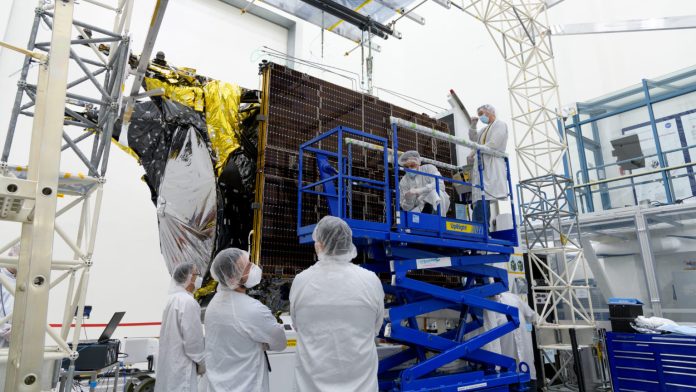In the United States, a three-year project investigating causes of voltage loss in cadmium selenide telluride thin films published its discovery of a new way to measure and track the mechanisms causing voltage loss within a device.
Working both with modules produced in the lab at Colorado State University, and by Ohio headquartered manufacturer First Solar, the group measured a characteristic called external radiative efficiency, that allowed it to better understand mechanisms behind voltage loss. “We learned that the main mechanism limiting voltage is not necessarily linked to defects within the bulk of the cell nor at the interfaces between different materials comprising the cell,” says Arthur Onno, assistant research professor at Arizona State University, who led the research. “That’s usually what is assumed in the CadTel community. But instead, it’s an issue with selectivity, which is when electrons within the cell go the wrong way and cancel each other.”
The group has published an explanation of the method and its use for a full analysis of CdTe devices in Nature Energy. With a fuller understanding of what limits the voltage, they were also able to suggest doping and other approaches to achieve higher efficiencies. The group also states that its measurement approach could also be applied to other cell materials including silicon and perovskites, and that it is already working on industrial applications. “We’re also focused on getting this technology into the hands of industry,” says Zachary Holman, an associate professor of electrical engineering in the Fulton Schools. “We have already built replicates of this measurement technique for a couple of domestic solar cell and module manufacturers.”
NASA completes new spacecraft solar installation
Ahead of a planned launch in August, NASA this week announced that it has completed the construction of the solar arrays that will power its Psyche spacecraft on a 2.4 billion kilometer mission to study a metal-rich asteroid.
“Seeing the spacecraft fully assembled for the first time is a huge accomplishment; there’s a lot of pride,” said Brian Bone, who leads assembly, test, and launch operations for the mission at NASA’s Jet Propulsion Laboratory in Southern California. “This is the true fun part. You’re feeling it all come together. You feel the energy change and shift.”
After launch, the solar arrays will deploy, and provide all of the power for the spacecraft’s 3.5-year journey to the asteroid, located between Mars and Jupiter. The cross-shaped solar arrays measure 75 meters, and with them fully deployed the spacecraft is roughly the size of a tennis court. Near Earth, the full array’s capacity is around 21kW, but this will be reduced to just 2kW closer to the mission’s destination. “These arrays are designed to work in low-light conditions, far away from the Sun,” explained Peter Lord, Psyche technical director at Maxar Technologies where the panels were designed.
Lightweight, flexible III/V cells for future space applications
While NASA is preparing to launch a foldable solar array into space later this year, research continues into making these cells even more powerful, as well as lighter and flexible – to potentially allow an array to roll up into an even smaller space before deployment.
Working with high efficiency materials used in solar cells for space and satellite applications, scientists led by Germany’s Fraunhofer ISE simulated various cell designs, each based on a flexible triple junction layer approximately 10 microns thick. The cells were divided into three ‘generations’ and tested under “AM0” irradiation, to represent the light spectrum outside of Earth’s atmosphere, before and after being particle irradiation similar to what the cells would be exposed to in space. The cells and testing process are described in full in a paper published in Progress in Photovoltaics.
“The power-to-mass ratios of the presented solar cells of 3.0 W/g [before irradiation, or beginning of life] and 2.6 W/g [after irradiation, or end of life] are already three to four times higher compared with space solar cells on thin germanium substrates and can compete with best published values for thin-film solar cells,” the group says, further noting that its fabrication process is based on a reusable substrate, with potential for further cost reduction.
Ultrathin solar at 9.17% efficiency
Scientists in Spain and the UK worked with silver-bismuth-disulfide (AgBiS2), to fabricate a device less than 1000 nanometers thick. Their devices achieved 8.85% efficiency certified by an accredited lab in the US, and themselves measured a top efficiency of 9.17%.
While silver is a rare and expensive material to work with, the group noted that other thin-film solar technologies rely on rare materials such as indium or tellurium, and their approach uses no toxic materials and does not require temperatures higher than 100 C, bringing potential for low-cost manufacturing.
The cells are described in full in a paper published in Nature Photonics. Key to fabricating a device so thin was a mild annealing process that allowed them to engineer particle distribution on the surface of the device, and optimize its light absorption properties. The group says it will now work on further optimizations to reach higher efficiency. “the devices reported in this study set a record among low-temperature and solution processed, environmentally friendly inorganic solar cells in terms of stability, form factor and performance,” said Gerasimos Konstantatos, professor at the Barcelona Institute of Science and Technology. “We are thrilled with the results and will continue to proceed in this line of study to exploit their intriguing properties in photovoltaics as well as other optoelectronic devices”.






